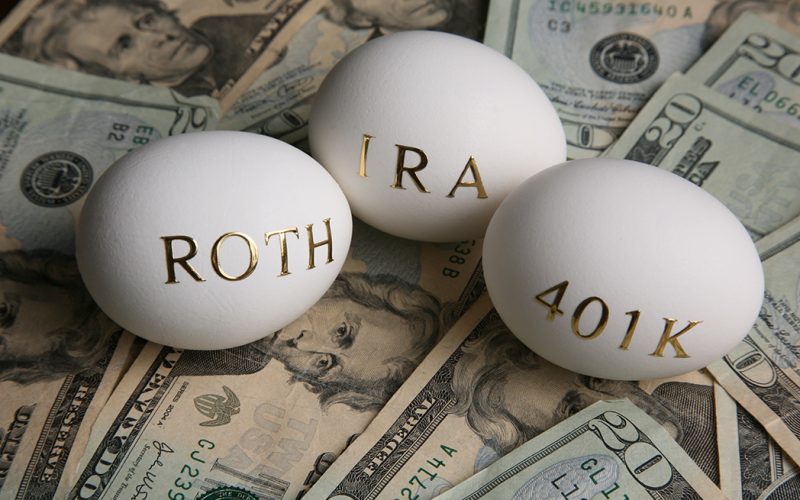Many employers now offer Roth 401(k) retirement accounts in addition to traditional 401(k) plans, giving employees another avenue to save for retirement. What is the distinction between the two accounts? Should you consider establishing a Roth?
We’ll look at how Roth 401(k) plans compared to traditional 401(k) plans work, their rules, and what to think about before making contributions and withdrawals to one.
In 2006, the Roth 401(k) account made its debut in the retirement investment world. It is an employer-sponsored investment savings account that allows employees to save for retirement with after-tax money. It was created by a section of the Economic Growth and Tax Relief Reconciliation Act of 2001 and is modeled after the Roth IRA.
What Is Roth 401(k)?
A Roth 401(k) is a type of employer-sponsored retirement savings plans funded with after-tax earnings.
That is, income tax is paid immediately on earnings withdrawn from each paycheck and placed into the retirement account by the employee. Withdrawals from the account will be tax-free after the employee retires.
This is in contrast to a traditional 401(k) plan, which is funded with pretax dollars. The payroll deduction is deducted from the employee’s gross compensation. Only when the money is taken from the account will income taxes be due.
Many, but not all, employers that provide 401(k) plans provide both Roth and traditional 401(k) alternatives.
Participants in 403(b) plans are also able to open a Roth IRA.
Although the option to contribute to a Roth 401(k) was due to expire at the end of 2010, the Pension Protection Act of 2006 extended the option.
Benefits of a Roth 401(k) Plans
The advantages of a Roth 401(k) plans are largely dependent on your point of view. From the standpoint of the government, it generates current revenue in the form of tax dollars. This is in contrast to a traditional 401(k), where investors receive a tax deduction for their contributions. Because of this deduction, funds that would otherwise be lost to the IRS remain in the account tax-deferred until withdrawn.
From the investor’s standpoint, the account is expected to expand over time, and money that would have been lost to taxes would instead work for the investor for all of those years. Because the tax deferral stops when the money is removed from the account, the government also wants those assets to increase. In effect, the government provides you a tax credit now in the hopes that there will be more money to tax later.
The Roth 401(k) works in the opposite direction. Money earned today is taxed today. If you deposit this after-tax money into your Roth, withdrawals after the age of 59 1/2 will be tax-free if the account has been funded for at least five years. Investors are drawn to the idea of tax-free money during retirement.
The thought of tax revenues being paid today rather than postponed appeals to the government. It’s so appealing that lawmakers have proposed replacing traditional tax-deductible IRAs with accounts like the Roth 401(k) and Roth IRA.
Factors for Consideration
Several reasons may influence your decision to open a Roth 401(k).
- Your firm may not provide the Roth 401(k). Companies are free to opt out, and in order to offer such a plan, employers must set up a tracking system to separate Roth assets from the company’s present plan. This could be an expensive prospect, and your employer may decide against it.
- Unlike Roth IRAs, Roth 401(k) participants are compelled to take minimum distributions at the age of 72, forcing investors to take distributions even if they don’t need or want them.
- Rolling over to a Roth IRA can escape the distribution requirement, but it is an administrative nuisance, and legislators can modify the rules at any time to prohibit such transfers.
- Having both accounts allows you to withdraw funds from tax-free and/or tax-deferred accounts, which can help you manage your taxable income in retirement.
- Any employer matching contributions made to your Roth 401(k) must be put into a traditional 401(k) account.
Roth 401(k) Plans Withdrawal Rules
A Roth 401(k) withdrawal rules are not as flexible as those of a Roth IRA.
- Unlike an IRA, you cannot withdraw contributions from a Roth 401(k) at any time. For distributions, it has a five-year rule; you must keep the account for five years before distributions are declared qualified and can be taken tax-free. This limitation applies even if you have reached the age of 59 1/2 when retirement distributions are generally permitted. That’s something to think about if you’re getting a late start and need the money right away. In that situation, a Roth IRA could be a better option.
- Then there’s the other option: you’d rather not have any access to the money at all. Roth 401(k)s, like traditional 401(k)s and traditional IRAs, require you to begin drawing distributions at the age of 72. These are referred to as needed minimum distributions. However, the Roth 401(k) provides a simple way out: its balance can be rolled immediately into a Roth IRA without incurring any tax consequences. Because the Roth IRA does not require minimum distributions, you can keep the money and pass the account on to your heirs.
401(k) Plans (Traditional and Roth)
Individuals who wish to save for retirement may do so through a 401(k) or Roth 401(k) plan. Both schemes are called after the part of the United States Internal Revenue Code that gave rise to them. Both plans provide tax benefits, either now or in the future.
Traditional 401(k)s allow you to defer income taxes on contributions and earnings. Contributions to Roth 401(k) plans are made after taxes, and the tax benefit comes later: gains can be withdrawn tax-free in retirement.
What are the Similarities Between a Traditional and a Roth 401(k)?
To begin, consider what a traditional 401(k) and a Roth have in common.
First and foremost, both of them are workplace retirement savings alternatives. You can enjoy the convenience of having your contribution drafted from your paycheck with either type of 401(k) plan.
Second, both can have a corporate match. Approximately 86 percent of employers that offer a 401(k) or equivalent program match employee contributions. If you have the opportunity to work for a company that provides a match, take it. Your boss is providing you with free money!
Third, the contribution limit for both types of 401(k)s is the same. In 2022, the annual contribution cap is $19,500, or $26,000 if you are over 50. The ability to invest so much each year is a significant benefit of either form of 401(k), especially when compared to the Roth IRA’s contribution restriction of $6,000 each year.
The Roth incorporates some of the finest aspects of a 401(k), such as flexible contribution methods and the possibility of a company match, if your employer provides one. Their parallels, however, cease there. Let’s take a closer look at the distinctions between these two retirement savings alternatives.
What Is the Difference Between a 401(k) and a Roth 401(k)?
The primary distinction between a traditional 401(k) and a Roth is how your contributions are taxed. Taxes can be perplexing (not to mention inconvenient to pay! ), so let’s start with a basic definition before delving into the nuances.
A Roth 401(k) is a retirement savings account that is set up after taxes. That means your contributions have already been taxed before they are deposited into your Roth account.
A traditional 401(k) on the other hand is a pretax savings account. When you participate in a traditional 401(k), your contributions are made before they are taxed, lowering your taxable income.
Roth 401(k) vs. Traditional 401(k): Advantages and Disadvantages
| Roth 401(k) | Traditional 401(k) | |
| Contributions | The contributions are made with after-tax dollars (that means you pay taxes on that money now). | Contributions are made with pre-tax dollars (that lowers your taxable income now, but you’ll pay taxes later in retirement). |
| Withdrawals | The money you put in and its growth is not taxed. However, your employer match is subject to taxes. | All withdrawals will be taxed at your ordinary-income tax rate. Most state income taxes apply too. |
| Access | If you’ve held the account for at least five years, you can start taking money out once you are age 59 1/2. You or your beneficiaries can also receive distributions due to disability or death. | You can start receiving distributions at age 59 1/2, no matter how long you’ve had your 401(k). So, you or your beneficiaries can also receive distributions due to disability or death. |
Contributions
What effect do such definitions have on your retirement savings? Let’s start with your contributions.
Your money is invested in a Roth 401 after it has been taxed. That implies you’re paying taxes now and getting a little less money in your paycheck.
The contributions to a traditional 401(k) are tax-deductible. They are deducted from your gross earnings before your paycheck is taxed.
You might be asking why someone would contribute to a Roth if doing so implies paying taxes now. If you simply consider the contributions, that is a reasonable question. But bear with us. What occurs when you start making money in retirement is a significant benefit of a Roth.
Retirement Withdrawals
The most significant advantage of a Roth 401(k) is that because you previously paid taxes on your contributions, your withdrawals in retirement are tax-free. Any company match in your Roth account will be taxable in retirement, but the money you put in—and its growth!—is all yours. When you spend that money in retirement, no taxes will be deducted.
In contrast, if you have a traditional 401(k), you will have to pay taxes on the amount you remove at retirement based on your current tax rate.
Let’s imagine you have a million dollars in your nest egg when you retire. That’s quite a collection! That $1 million is yours if you have it invested in a Roth.
If you have $1 million in a traditional 401(k), you will have to pay taxes on any withdrawals in retirement. If you’re in the 22% tax rate, it means $220,000 of your $1 million is going to taxes. That’s a tough pill to swallow, especially after you’ve worked so hard to accumulate your savings!
It goes without saying that if you don’t pay taxes on your withdrawals, your nest egg will last longer. That is a fantastic feature of the Roth 401(k)—and, for that matter, the Roth IRA.
Access
Another distinction between a Roth and a traditional 401(k) is your ability to access the funds. You can begin receiving distributions from a traditional 401(k) at the age of 59 1/2. Also, you can start withdrawing money from a Roth at the same age, but you must have held the account for five years.
You have nothing to be concerned about if you are still decades away from retirement! However, if you are nearing 59 1/2 and considering beginning a Roth 401(k), you should be aware that you will not have access to the funds for five years.
Here are a few things to consider when deciding between a Roth 401(k) and a traditional 401(k).
When it comes to paying taxes,
Contributions to a traditional 401(k) are made with pre-tax dollars. This means that any money you contribute is deducted directly from your paycheck, lowering your taxable income for the year. The funds will not be taxed until they are withdrawn during retirement.
If you earn $50,000 per year and contribute $5,000 to a 401(k), you will pay income taxes on only $45,000.
Contributions to a Roth 401(k) are made after-tax monies. So, if you earn $50,000 per year and contribute $5,000, you will still owe full tax on the $50,000. And you don’t have to pay taxes again when you withdraw the money in retirement.
Slott responds, “You don’t get a deduction.” However, “you gain something for your money because you don’t get a deduction.” That money will grow tax-free for you.” Because Roth 401(k) contributions are already taxed, the investment is entirely yours as interest accumulates over time.
A traditional 401(k) may make more sense than a Roth plan if you expect to be in a lower tax bracket in retirement. However, if you are currently in a low tax rate and feel you will be in a higher tax bracket when you retire, a Roth may be a better alternative.
However, keep in mind that forecasting future tax rates might be difficult because no one knows how things will evolve in the future.
How old are you?
According to Slott, young individuals are typically in lower tax levels and have decades to save for retirement. When these variables are considered together, a person is often an excellent candidate for a Roth account.
“The most valuable asset any human can have is time, and young people have more of it. So it’s a no-brainer with young people,” Slott says. “It’s a no-brainer to opt with the Roth.”
Where you reside
According to Marianela Collado, a CPA and financial advisor at Tobias Financial, your state of residency should be examined in addition to evaluating whether pre-tax contributions are most beneficial for you.
If you now live in a place that collects both state and federal income taxes but wants to retire to a state that does not collect income taxes, such as Florida or Texas, it may be prudent to choose a traditional 401(k).
Collado explains that doing so will result in greater tax savings on your distributions upon retirement.
How much money can you afford to save?
In 2022, the annual contribution limit for both traditional and Roth 401(k)s is $19,500, with a catch-up contribution of $6,500 for members age 50 and over.
This is far more than is permitted in a Roth IRA, where contributions are limited to $6,000, plus an additional $1,000 for those aged 50 and up. This might make Roth an appealing alternative for consumers who wish to save more money after taxes.
However, even if you pick a Roth 401(k), all business matches will be deposited into a traditional 401(k). That means you’ll have to pay income tax on any employer contributions you make, as well as the earnings on those contributions when you withdraw the money in retirement.
Here are a few more things to consider: Both forms of 401(k)s require you to begin taking minimum distributions at the age of 72. Early withdrawals made before the age of 5912 are normally subject to an additional 10% penalty.
Related: Trust Wallet Review 2023: Is Trust Wallet Safe? (Updated!!!)
You may wish to employ both.
If you can’t decide between the two, try putting some money into both, as tax risk diversification is key, according to Slott. Again, forecasting future tax rates is difficult. Investing in retirement accounts with diverse tax advantages can minimize tax risk in the same way that diversifying one’s financial portfolio does.
Contributing to only one option is analogous to “putting all your eggs in one basket,” according to Slott.
However, keep in mind that in 2023, you can only donate a total of $19,500.
Why Do We Advise the Roth 401(k)?
You’re already on the correct track if you invest consistently every month, whether in a Roth or, a traditional 401(k), or even a Roth IRA! The most significant aspect of wealth creation is constant monthly savings, regardless of market conditions.
But, if we had to choose between a traditional 401(k) and a Roth, we’d take the Roth every time! We’ve already discussed the differences between these two sorts of accounts, so you’re undoubtedly aware of the advantages. But, just to be clear, these are the main reasons why Roth wins.
Tax Break
It may be tempting to postpone paying taxes to receive a somewhat larger income now. But consider this: you’re already putting forth the effort to save for retirement. Wouldn’t you want to take advantage of the opportunity to make your money go even further?
Another factor to consider is that no one can predict how tax brackets or percentages will change in the future, especially if you are still decades away from retirement. Are you willing to accept that risk?
The Emotional Cost
Whether you like it or not, it’s difficult to separate emotions from investment. Imagine reaching retirement age and seeing your $1 million nest account reduced to less than $800,000 due to taxes! You’d rather pay taxes now than see all that money disappear later. You’ll miss $100,000 far more than you’ll miss $100 in a paycheck right now.
You won’t even miss the money you’re paying in taxes if you can get into the habit of donating 15% of every paycheck to your Roth 401(k) early on. And when it comes retirement to retire, you’ll be relieved that you don’t owe the government a portion of your hard-earned savings.
Who Can Participate in a Roth 401(k)?
You are eligible if your company provides it. A Roth 401(k) has no income constraints, unlike a Roth IRA. That is an excellent aspect of the Roth option. You can contribute to a Roth 401(k) regardless of your income level.
If you don’t have access to a Roth option at work, you can still take advantage of the Roth benefits by opening a Roth IRA with the help of your investment professional. Just keep in mind that there are income limits when contributing to a Roth IRA.
What Are the Limits on Roth 401(k) Contributions?
The 401(k) contribution limit for 2022 is $19,500. This contribution limit applies to 401(k) contributions made in either a Roth or traditional 401(k). That means that if you contribute to both, the total of your contributions cannot surpass that amount. In case you’re wondering, your employer’s contributions are not included toward the maximum.
The contribution maximum rises to $26,000 if you are 50 or older.
What Should I Put Into a Roth 401(k)?
We recommend that you save 15% of your income for retirement. You can invest your entire 15% in a Roth 401(k) at work if it has good mutual fund selections. Assume you earn $60,000 per year. That implies you’d put $750 into your Roth account each month. Investing in the future is simpler than you might think!
What Types of Mutual Funds Should I Put in My Roth 401(k)?
Diversifying your portfolio is essential for keeping a healthy level of risk in your retirement savings. That is why it is critical to diversify your investment portfolio between four types of mutual funds: growth and income, growth, aggressive growth, and overseas funds.
If one type of fund is underperforming, the others might assist keep your portfolio balanced.
Should I Switch My Traditional 401(k) to a Roth 401(k)?
When it comes to converting your retirement assets to a Roth account, there is no one-size-fits-all solution. A Roth conversion is a terrific method to take advantage of tax-free growth on your accounts if it makes sense for your situation. However, keep in mind that rolling over a traditional 401(k) requires you to pay taxes on it right away. And, if you convert a huge quantity all at once, you may find yourself in a higher tax band… which implies a larger tax payment.
For example, if you roll over $100,000 and are in the 22% tax rate, you must come up with $22,000 in cash to settle the taxes. Don’t take that money out of the investment!
If you can pay your taxes in cash without dipping into your nest egg and you’re still a few years away from retirement, it can make sense to roll it over. However, before you roll over your accounts, consult with an experienced investing adviser. They will assist you in understanding the tax implications of rolling over your 401(k) and how to prepare for it.
You can have a Roth IRA as well as a Roth 401(k)
You can have both a Roth IRA and a Roth 401(k) at the same time. However, keep in mind that to participate, your employer must offer a Roth 401(k). Meanwhile, given the specified income limits, anyone with earned income (or any spouse whose partner has earned income) can open an IRA.
If you don’t have enough money to max up contributions to both plans, experts recommend starting with the Roth 401(k) to take advantage of the full company match.
Which is better: a Roth IRA or a Roth 401(k)?
The ideal account for your needs is determined by your existing and prospective financial situations, as well as your ambitions.
High-income people who want to contribute to retirement accounts each year should consider a Roth 401(k), which has no income limits. Individuals who desire to make big contributions can contribute more than three times as much to a Roth 401(k) as they can to a Roth IRA.
Those looking for more flexibility with their assets, such as no minimum distributions, may prefer a Roth IRA. This is especially useful if you intend to pass the account to an heir. However, Roth 401(k) funds can be rolled over into a Roth IRA at a later date.
Tax diversification allows you to cover all of your bases.
If you are unsure about your tax rate, income, and expenditures in retirement, one solution could be to contribute to both a Roth 401(k) and a traditional 401(k). The combination will give you both taxable and tax-free withdrawal possibilities. As a retired individual or married couple with both Roth 401(k) and traditional 401(k) plans, you might use your tax status to select which account to access.
“Because you never know what future tax rates will be, having the option to manage taxes through different accounts is crucial and helpful,” says Rob.
For example, you might take RMDs from your traditional account and withdraw any excess funds from your Roth account tax-free. That means you may withdraw a large sum of money from a Roth 401(k) one year, say, to pay for a dream vacation, without fear of incurring a significant tax liability.
Aside from the added flexibility of being able to manage your marginal income tax bracket, lowering your taxable income in retirement may be beneficial for a variety of reasons, including lowering the amount you pay in Medicare premiums, lowering the tax rate on your Social Security benefits, and maximizing the availability of other income-based deductions. To preserve your retirement goals, make sure to examine all of your available possibilities.
Can I withdraw contributions from my Roth 401(k) without paying taxes or penalties?
Yes, you can withdraw contributions from your Roth 401(k) without paying taxes or penalties. Contributions to a Roth 401(k) are made with after-tax dollars, so they are not taxed when they are withdrawn. However, earnings on contributions are subject to taxes and penalties if withdrawn before age 59 1/2.
What is the difference between a Roth 401(k) and a Roth 401(k) conversion?
A Roth 401(k) is a type of employer-sponsored retirement plan, while a Roth 401(k) conversion refers to the process of converting a traditional 401(k) or other pre-tax retirement account into a Roth 401(k). The main difference between the two is the tax treatment of contributions and withdrawals. Contributions to a Roth 401(k) are made with after-tax dollars, while contributions to a traditional 401(k) are made with pre-tax dollars. Withdrawals from a Roth 401(k) are tax-free, while withdrawals from a traditional 401(k) are taxed as ordinary income.
Can I convert my Roth 401(k) to a Roth IRA?
Your Roth 401(k) can be rolled over to a Roth IRA, that much is true. A Roth 401(k) conversion describes this change. Transferring money from a Roth 401(k) to a Roth IRA is the next step. In order to ensure that the conversion is carried out correctly, it is recommended to consult a financial expert.
Roth 401(K) FAQ’s
What is the difference between a Roth 401k and a standard 401k?
Your money is invested in a Roth 401(k) after it has been taxed. That implies you’re paying taxes now and getting a little less money in your paycheck. Contributions to a traditional 401(k) are tax-deductible. They are deducted from your gross earnings before your paycheck is taxed.
How much money should I have in my 401k?
This is how much Fidelity experts recommend you have saved for retirement at each age: By the age of 30, you should have saved the equivalent of your annual pay. By the age of 40, you should have saved three times your annual pay. By the age of 50, you should have saved six times your annual pay.
What is the 5 year rule for Roth 401k?
The first five-year rule appears straightforward: To avoid paying taxes on Roth IRA distributions, you must wait five years after your first contribution to take money out.






